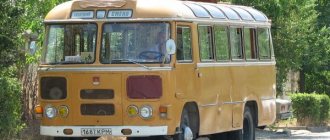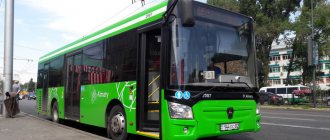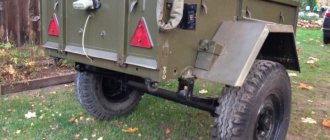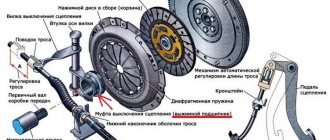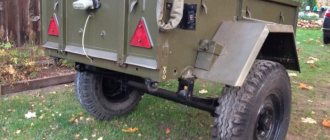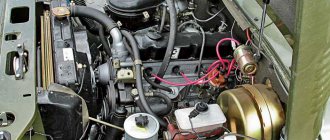Author: Kot shashlik
15 November 2022 08:57
Community: Autoworld
Tags: auto buses restoration oldtimer groove restoration retro cars
11773
29
2
PAZ 3201 is an all-wheel drive public transport bus model. Produced by the Pavlovsk plant from 1972 to 1982. The bus was intended for use in rural areas, on poor roads. The PAZ-3201, compared to other serial buses, has increased ground clearance and a different chassis.
0
Source:
See all photos in the gallery
One craftsman managed to acquire a rare copy of PAZ-3201-S. This model was the first in the world with all-wheel drive (serial). But these are not all the differences, namely 3201-C is the northern version, it used double glazing and did not have the usual windows on the roof itself.
Paz 3206: technical characteristics and photo of the bus
Even the usual classic “groove” of the 3205 model feels good on dry dirt roads: in fact, it was once created specifically for work on routes connecting cities and villages and not always rolled into asphalt. However, in the line of the Pavlovsk Bus Plant there is also a very extreme version of the “groove”, designed to work on real off-road conditions. Meet the PAZ-3206: plug-in all-wheel drive with inter-wheel locks, a transfer case with a reduction gear, and a body lifted over the axles right from the factory! And all this, by the way, while maintaining the load-bearing structure of the body. It simply has no direct analogues among modern serial foreign technology!
The design of the PAZ-3206 was carried out from the very beginning of the 1980s, and the first prototypes were built at the same time, but production began only in 1994. Since then, several hundred “zero-sixths” have been shipped to consumers every year, and their total circulation has not yet exceeded ten thousand copies. So the car is actually quite rare! And the school modification that we will talk about today is exotic squared away: only a few hundred of these buses were made under the national project “Education”. The test copy, by the way, was intended for delivery to the Irkutsk region. Shall we arrange a pre-trip inspection? We sit in the cab, open the folding lid of the engine compartment... Bah! And lurking there is probably one of the most “long-lasting” engines in the world - the ZMZ gasoline “eight”! It was developed several years before Gagarin flew into space. And this will probably be difficult for many to believe, but to this day it is produced in a CARBURETTOR version! Yes, and it was alternately brought to compliance with Euro-2, Euro-3 and Euro-4 standards, attaching to it an electronic carburetor control system, an exhaust gas recirculation system and a converter. In the most recent modification, it develops 122 hp. power and 280 Nm of torque from 4.67 liters of displacement.
In the engine compartment there is a ZMZ V8 carburetor
The second time I had to be surprised when I looked at the gearbox: is it really still a 4-speed gearbox?! Yes, indeed: and this prehistoric unit is still in service. True, “technical progress” also did not bypass it: if earlier - back when the GAZ-53A was in use - synchronizers were only in third and fourth gears, then later... they were abandoned altogether! That is, once again, spelled out: the box is UNSYNCHRONIZED! What, scary? )) In fact, it’s not scary at all, the gears in it change easily, but double clutch release and throttle shifting are necessary, yes. Well, in fairness, it should be noted that the use of a 4-speed gearbox on a school bus is completely justified, since due to the speed limiter triggered at 60 km/h, the need for fifth gear simply does not arise here.
It’s easy to guess that the PAZ-3206 borrowed the main units of the all-wheel drive transmission from Gorky trucks - first from the GAZ-66, later from the GAZ-3308. The transfer case is installed separately from the gearbox: they are connected by a short intermediate driveshaft. In turn, the torque is transferred from the transfer case to the axles by two single driveshafts. The all-wheel drive is made according to the Part time scheme - that is, the front axle is connected rigidly, there is no center differential in the transfer case. But there are cam “self-blocks” in both bridges! Well, we can mention that the gear ratio of the “lower” in the “razdatka” is 1.982.
The progressive characteristics of the rear suspension are provided by corrective springs installed together with longitudinal springs: due to the stretching of the springs, the stiffness of the suspension non-linearly increases with increasing load. To improve lateral stability, stabilizers are installed on both axles (the PAZ-3205 does not have them at all)
Compared to conventional rear-wheel drive "grooves", the all-wheel drive model has a body raised above the axles by 10 centimeters higher. This has significantly improved the ramp angle and approach angles. The other side of the coin is that the height of the center of gravity of the PAZ-3206 has also increased; putting it on its side is much easier than the PAZ-3205. For this reason, all four-wheel drive “grooves” are only allowed to carry seated passengers.
Visual comparison: PAZ-3206 (4x4) next to PAZ-32053 (4x2). It is clearly noticeable that the body of the “all-wheel drive” vehicle is raised higher above the road
Rear-wheel drive “grooves” have been produced for a decade and a half on original KAAZ axles, which have brake mechanisms for pneumatic drive and energy accumulators. But no one is making a front drive axle with air brakes yet (it will probably appear only on promising Sadko NEXT trucks). So the working brake system on the PAZ-3206 is the so-called “old” type, pneumohydraulic, and the parking brake is mechanical, acting on the transmission. Well, another hereditary feature due to the use of the GAZ front axle is a small turning angle of the wheels: if the same PAZ-3205 is capable of turning around on a 17-meter platform, then the PAZ-3206 requires 24 meters to perform the same maneuver.
The front drive axle of the PAZ-3206 is unified with the GAZ-33086
Now a few words about the features of the school “groove”. The fact is that any school bus in our country actually has a number of fundamental differences from the ordinary bus on the basis of which it is built, and the conversion process is by no means limited to just changing the color and applying the corresponding inscriptions on the body. All school buses are designed in accordance with GOST, which clearly regulates the necessary modifications both in the interior and in the body: seats with high backs and seat belts, luggage racks or racks for placing briefcases, driver signal buttons at each seat, reduced height of footrests are required at the entrance, etc. So that even the smallest passengers can climb into the cabin without the help of adults, high-floor school buses are equipped with an additional folding step, which automatically extends from under the bottom when the service door is opened.
Any school bus is required to have an additional retractable step at the entrance and places to place briefcases in the cabin: some people install luggage racks, others use racks like this
Even though the “groove” is a school car, the seats in its interior are spaced at a very large pitch: sometimes in city “minibuses” the seats are closer together! If necessary, adults will also sit in the school PAZ. Apparently, the pitch of the seats was chosen with an eye to the fact that among high school students there are now regularly accelerators over one meter tall, and they have to ride on the same bus with first-graders.
Reversible seats in the front provide space for two accompanying persons. Child seats are installed only in the direction of travel, on podiums, and are equipped with seat belts. On this bus they are still of the so-called old style - 2-point, but with inertial coils: simple and convenient. And recently, 4-point seat belts became mandatory for school buses. It seems like, okay, concern for safety? Unfortunately, everything is not so simple. Such belts are usually no longer equipped with inertial reels, but will children be able to fasten them correctly?! After all, each time such a belt needs to be adjusted manually, otherwise it turns into a completely stupid thing. I’ll tell you straight: not every adult can cope with this quickly. And the child... most likely, will simply not wear the seat belt at all: it’s too difficult...
What else is cool about a school bus? I have already spoken about the speed limiter: upon reaching 60 km/h, the electronic accelerator pedal becomes “empty” and does not allow you to “give more gas”. You won’t be able to start driving the “schoolboy” even with the service door open: the engine won’t pick up speed. When reversing, a loud beep sounds. And finally, in the school “groove” there is a signaling installation with a speaker installed on the roof.
Well, is it time to go for a ride? Sitting behind the wheel of the PAZ-3206, it’s hard not to feel the considerable age of the design: the driver’s workplace here has changed little since the eighties. From time to time, a certain set of measures for ongoing modernization was introduced into the “grooves” of the 3205 family: they installed a high partition behind the driver, a new steering column cover and heated mirrors, updated the instrument panel and changed the driver’s seat. In 2007, the high beam control was finally moved to the steering column switch (previously it was turned on by a button on the floor). But the ergonomics on these machines have never been radically updated. To sit behind the wheel really comfortably, the driver, apparently, must be short. I am 187 centimeters tall, and in order to fit my legs under the steering wheel, I had to push the seat all the way back, and then lean forward towards the steering wheel. At the same time, my back could only dream of some kind of support.
As I already said, the gearbox is on a “groove”, although it does not have synchronizers, but when you use the throttle and double-depress the clutch, the gears stick in easily. But the lever itself has too much travel: if you want to engage first or second, you must first press your right knee into the steering column casing to make room for the lever, and when you engage second gear, you also have to press the lever into the seat cushion. In turn, when you turn on the rear (according to the classic scheme - to the right and back), the lever almost rests on the hood.
When engaging first gear, the knee has to be pressed against the steering column casing; when engaged, the second lever is pressed into the seat
The handbrake and very tight transfer case levers are located on the right-behind side of the driver’s seat.
Finally, another feature of the old “grooves” is a consequence of the close proximity of the driver and the engine: the heat from the latter still penetrates into the cabin. And even if this is good in winter, it definitely creates discomfort in summer. It’s good that the ZMZ G8 makes little noise, and consider that there are no vibrations at idle.
The joint between the cabin bulkhead and the rear wall of the engine compartment gets very hot.
However, you can easily forgive all these shortcomings of the PAZ-3206 as soon as you drive it off the asphalt. Being shod with “toothy” Amtel K-100 tires, and with a cam differential, the bus can easily navigate slippery sections of dirt roads and grassy slopes even with rear-wheel drive. It was only necessary to tuck the front axle and lower axle when we started plowing through hills and ravines.
The “groove” suspension has a lot of articulation, so to manage to “catch the diagonal” on it requires a lot of effort...
We were never able to hang the rear wheels in this ditch. A standard rear-wheel drive “groove” will not get through here, but our all-wheel drive moved on even without slipping
When driving through ditches and ravines, the main limiting factor is the rear overhang of the body: when the traction properties of the tires and traction capabilities are still behind the eyes, the rear bumper is already starting to cling to the ground. Does this indicate poor geometric cross-country ability? Under no circumstances: you can’t get here in principle on a rear-wheel drive PAZ-3205! Not to mention any other city buses...
It would be more correct to say that the cross-country ability reserves built into the chassis of the “zero sixth” model are even excessive for a bus. But, of course, if you try, you can get stuck on an all-wheel drive “groove”: in the same deep rut, it will sit on bridges just as quickly as a regular PAZ-3205, because their tire sizes are the same, and therefore the ground clearance is the same (264 millimeters under the rear axle)
Let's sum it up? I can say for sure that there is no need to worry about those rural schoolchildren who are transported by PAZ-3206 buses: they will reach their destination in any weather - such a serious all-terrain vehicle will not let you down. But I myself would not want to be the driver of such a “groove”, since driving this car is not an easy job, physically difficult. Still, in the 21st century, you expect a greater level of comfort from a car, even (or even more so?) a working one. A completely different matter is the PAZ buses of the new “Vector” and “Vector NEXT” families, but about them - some other time))

